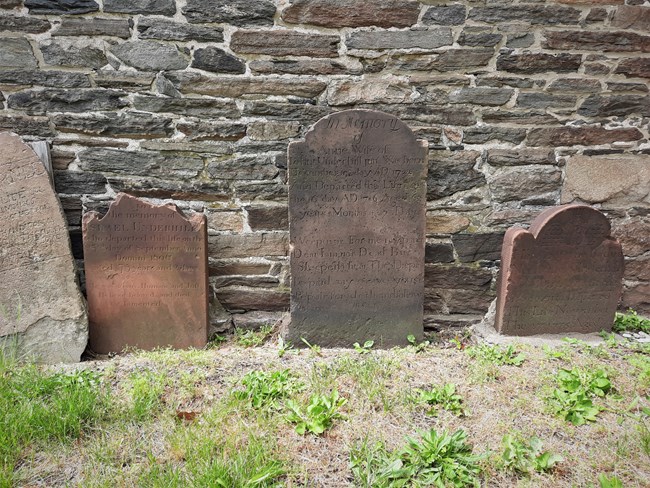Last updated: January 27, 2022
Article
Colonial era burial markers from the Bronx, re-located to St. Paul's in the 20th century

NPS
Burial Markers from the 18th century installed at St. Paul’s Church in the 20th century
An interesting confluence of urban development, family heritage and preservation concerns led to the 20th century installation behind St. Paul’s Church of three 18th century sandstone burial markers.
The reddish brown stones memorialize members of the Underhills, a prominent family who lived about three miles from St. Paul’s in what is today the Williamsbridge neighborhood of the Bronx. In colonial times, their land was a peripheral division of the town of Eastchester, coterminous with the parish of St. Paul’s. Some family members worshipped here in the late 18th century, including Israel Underhill, a militia officer in the Revolutionary War and one of the original pew holders in 1787.
Established as a churchyard in the early 1700s, St. Paul’s was a logical interment location for the deceased of local families. Yet, for various reasons some residents, including the Undershills, followed a concurrent tradition of burying family on private grounds, setting aside a portion of their acreage in southern Westchester County to establish a small cemetery. The first of these was Nathanael Underhill, who died at age 86 in 1775, on the eve of the American Revolution. Coffins bearing the remains of Anne Underhill, who passed away in 1786, and Israel Underhill, Nathanael’s son who died in 1806, were also buried in the family plot.
While the burial ground survived several land ownership transfers over more than 130 years, the small cemetery’s viability was eventually eclipsed through the requirements of urban expansion in the early 20th century. In 1812, the Underhills conveyed their lands to the Lorillard family, prosperous tobacco merchants and manufacturers. By the late 19th century the plot was encompassed in the Lorillard-Spencer estate, one of the area’s vast domains retained by wealthy families as summer retreats.
Underhill descendants sustained a right, or an easement, to the burial plot, although maintenance was negligible. A family member visiting the yard in 1890 recalled later that it was “in a dilapidated condition; gravestones broken and scattered about; the gravestone of Israel Underhill was broken off, and the condition of things was deplorable.” The consolidation of the five borough metropolis of Greater New York in 1898, leading to the establishment of the borough of the Bronx, created the circumstances for the transfer of the stones to St. Paul’s. Left over from an earlier custom, the small family burial plot was incongruous with expectations of land use in the nation’s largest city. The local development of a street grid, an urban imposition on the old rural landscape, compelled an alteration of the burial yard, which interfered with the planned route of 205th Street. New York City seized control of the property, with financial compensation paid to an Underhill family association.
An agreement between the family and the church vestry facilitated the movement of the sandstone markers to St. Paul’s sometime between 1913 and the early 1920s. The church records fail to record a reason for accepting the monuments, but proximity, the family’s membership in the 18th century congregation, and the 19th century burial here of more than a dozen Underhills establish a clear connection. Assembled more than a century earlier, simple wooden coffin boxes bearing the remains would have decomposed; disintegration of the cadavers was certainly advanced. These conditions help explain the reluctance to remove the remains of the Underhills. Though damaged, the extant gravestones, with legible inscriptions recording the memorial information of those former colonists, warranted preservation through shipment to a new location. The slender monuments to earlier Americans were stored in the wood shed at the church and later transferred to the receiving or holding vault which had been constructed in the 1850s as a temporary wintry location for coffins when frozen ground prevented opening up graves.
The sedimentary slabs remained there, almost forgotten for decades, until they were apparently “re-discoverd” by the church historian in the early 1970s. Carried carefully up the stairs of the vault, the stones were anchored with cement foundations against the exterior southern wall of the Bell tower, creating an Underhill corner.
They remain visible today, complimenting other representations of the great sandstone era of cemetery iconography. Nathanael’s stone, drawn from the quarries of northern New Jersey, features a puffy cheeked soul effigy with large wings and an impressive crown created by John Zuricher, colonial New York’s leading carver. Anne’s epitaph, notable for its phonetic spelling, reflects an additional irony since her remains are not interred with the stone:
Weep not For me my parents Dear I am not Dead But Sleepeth hear The Dept Is paid, my grave you see Prepair for death and follow me.
